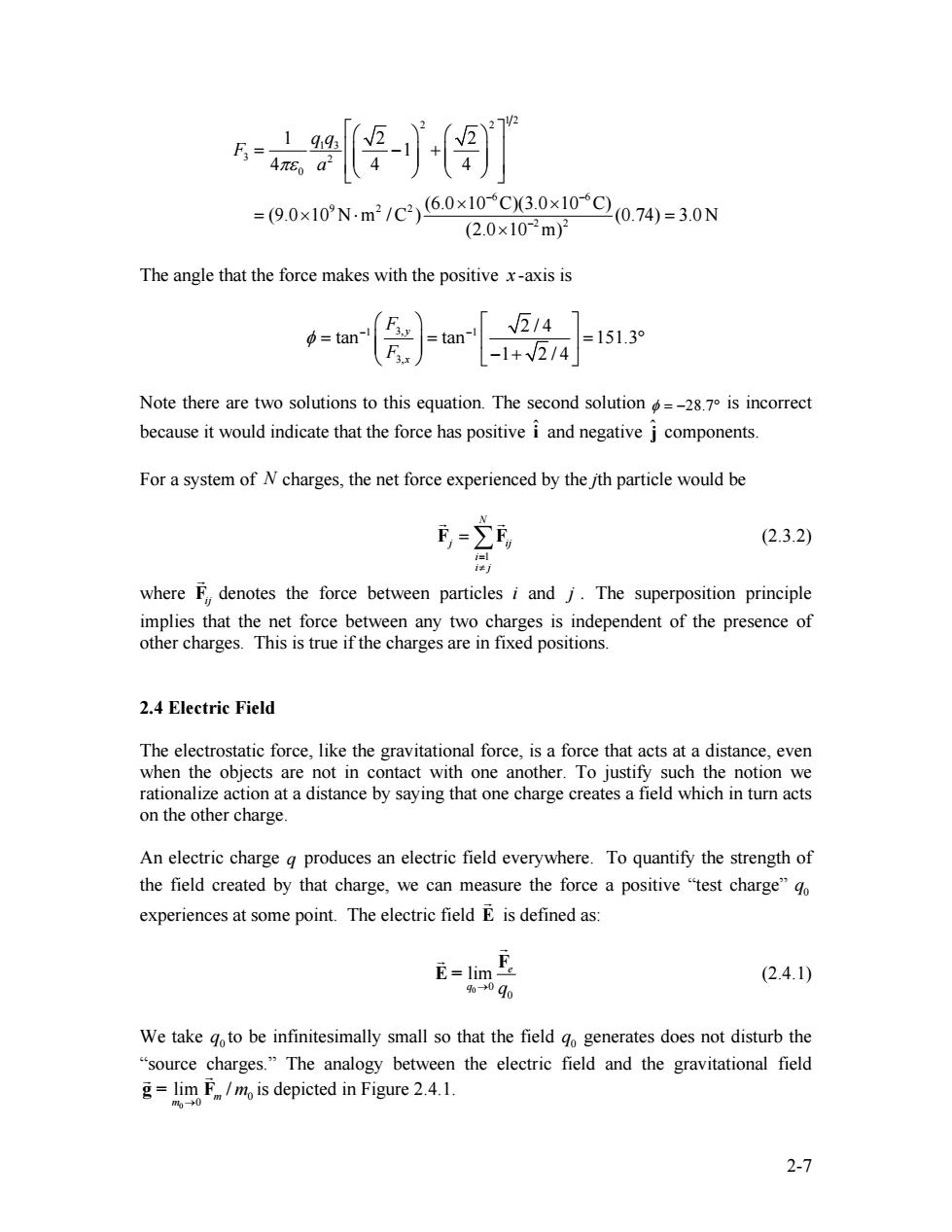正在加载图片...

-婴停-j =9.0x10N.m21c6.0x10C30x10*C0.74=30N (2.0×10-2m)2 The angle that the force makes with the positive x-axis is tar tan-i 514 =151.3° -1+V2/4 Note there are two solutions to this equation.The second solution 6=-28.7 is incorrect because it would indicate that the force has positive i and negative j components For a system of N charges,the net force experienced by the jth particle would be (2.3.2) i法j where F denotes the force between particles i and j.The superposition principle implies that the net force between any two charges is independent of the presence of other charges.This is true if the charges are in fixed positions. 2.4 Electric Field The electrostatic force,like the gravitational force,is a force that acts at a distance,even when the objects are not in contact with one another.To justify such the notion we rationalize action at a distance by saying that one charge creates a field which in turn acts on the other charge. An electric charge g produces an electric field everywhere.To quantify the strength of the field created by that charge,we can measure the force a positive "test charge"o experiences at some point.The electric field E is defined as: E=limE (2.4.1) 9%0q0 We take goto be infinitesimally small so that the field go generates does not disturb the "source charges."The analogy between the electric field and the gravitational field g=lim F/m is depicted in Figure 2.4.1. 2-71 2 2 2 1 3 3 2 0 6 6 9 2 2 2 2 1 2 2 1 4 4 4 (6.0 10 C)(3.0 10 C) (9.0 10 N m /C ) (0.74) 3.0 N (2.0 10 m) q q F πε a − − − ⎡ ⎤ ⎛ ⎞ ⎛ ⎞ = − ⎢ ⎥ ⎜ ⎟ + ⎜ ⎟ ⎜ ⎟ ⎢ ⎥ ⎝ ⎠ ⎝ ⎠ ⎣ ⎦ × × = × ⋅ = × The angle that the force makes with the positive x -axis is 1 1 3, 3, 2 / 4 tan tan 151.3 1 2 / 4 y x F F φ − − ⎛ ⎞ ⎡ ⎤ = = ⎜ ⎟ ⎢ ⎥ = ⎜ ⎟ ⎣ ⎦ − + ⎝ ⎠ ° Note there are two solutions to this equation. The second solution φ = −28.7° is incorrect because it would indicate that the force has positive and negative ˆ ˆ i j components. For a system of N charges, the net force experienced by the jth particle would be 1 N j i i j = ≠ F = ∑Fij G G (2.3.2) where denotes the force between particles i and Fij G j . The superposition principle implies that the net force between any two charges is independent of the presence of other charges. This is true if the charges are in fixed positions. 2.4 Electric Field The electrostatic force, like the gravitational force, is a force that acts at a distance, even when the objects are not in contact with one another. To justify such the notion we rationalize action at a distance by saying that one charge creates a field which in turn acts on the other charge. An electric charge q produces an electric field everywhere. To quantify the strength of the field created by that charge, we can measure the force a positive “test charge” experiences at some point. The electric field E 0 q G is defined as: 0 0 0 lim e q → q F E = G G (2.4.1) We take to be infinitesimally small so that the field generates does not disturb the “source charges.” The analogy between the electric field and the gravitational field is depicted in Figure 2.4.1. 0 q 0 q 0 0 0 lim / m m m → g = F G G 2-7